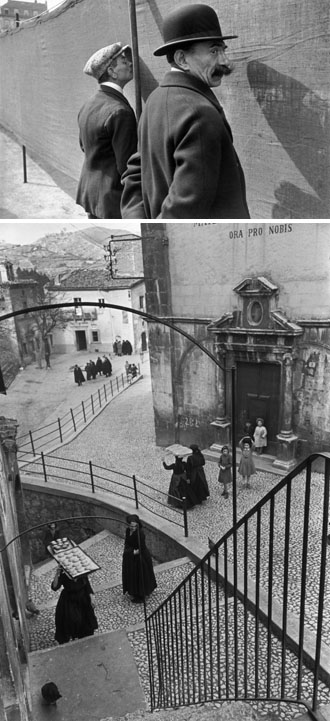Photos illuminate the ordinary

“Bruxelles”(1932), top, and “Aquila degli Abruzzi, Italie” (1951), above, by Henri Cartier-Bresson are part of his large-scale traveling retrospective now in Seoul. Provided by Henri Cartier-Bresson/Magnum Photos/EuroCreon
Why is he so famous? A large-scale retrospective of the French photographer, going on in Sejong Museum of Art in central Seoul until early September, will help Korean viewers understand it. It is a traveling exhibition and the last show curated when the “father of modern photojournalism” was still alive. It was curated by Robert Delpire and started in the National Library of France in 2003 before traveling to nine countries before coming to Korea.
“He found the genius of life from the ordinariness of everyday life,” said Lee Ki-myoung, director of the exhibition in Korea.
Shin Sue-jin, research professor of photography psychology at Yonsei University, also pointed that out, in her contribution to the JoongAng Sunday. “The exhibit will show that Cartier-Bresson focused on ‘decisive moments,’ different from ‘decisive events,’ ” she said. “He found out the ways of seeing familiar things in unfamiliar ways with his camera. There is his greatness.”
For that, “he rejected extreme angles that were different from the perspectives of people in everyday life,” Lee explained. “He also mainly used a standard lens.”
The first section of the exhibition, named “Aesthetics of the Moment,” focuses on such works by Cartier-Bresson. Among the exhibits is the iconic photo “Derriere la Gare Saint-Lazare,” which depicts a man striding through water behind the Saint-Lazare Station after a rain. His shadow on the water and his pose resemble a dancer in poster behind him.
“Exhibits in the section show rapid motions captured by using a small camera,” Lee said. “They show moments made up of perfect harmony and balance in the temporal and spatial integration.”
The entire exhibition features about 250 works selected from Cartier-Bresson’s vast library by Delpire. Also on display are personal documents and records, including photos of his family, press credentials and letters.
The exhibition is divided into five sections.
“Inner Sympathy,” the second section, features photographs showing intuitive sympathy with the subjects and those influenced by the automatism of surrealist art.
The third section, “Masters of the Face,” contains portraits for key figures of the 20th century. The photos in the fourth section, “The Truth of the Times,” juxtaposes images from everyday life with big historical events in Cartier-Bresson’s unique way.
“Humanism,” the final section, features works that show his affection for simple, humble people.
By Moon So-young [symoon@joongang.co.kr]
The show runs through Sept. 2 at the Sejong Museum of Art. Admission is 12,000 won ($10.55) for adults. The show is open 11 a.m. to 8:30 p.m. daily. Go to Gwanghwamun Station, line No. 5, exit 7 or 8.
For more information, visit www.hcbkorea.com.










with the Korea JoongAng Daily
To write comments, please log in to one of the accounts.
Standards Board Policy (0/250자)